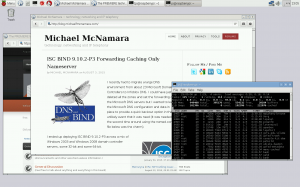I finally broke down and ordered a Raspberry Pi 2 Model B and here are my first thoughts after tinkering with this $35 device for a few hours. The default username is “pi” while the default password is “raspberry”.
In short I’m just flat out impressed, it’s amazing how far technology has come and what you can do with a $35 device. I haven’t touched a breadboard in more than 20 years now but I’m excited to pick one up and start tinkering again. The electrical engineer in me is giddy with excitement and anticipation. While the computer scientist in me is eager to write some code and see how this little device can literally integrate into the real world.
I was impressed by how responsive the GUI was on the Raspberry Pi 2. It felt faster then some of the older Intel Core 3 laptops I have lying around the house. Using the USB  wireless adapter that was included in the kit I purchased I was quickly able to get the Raspberry Pi to join my WPA2-PSK wireless network. Within 15 minutes I had a X windows desktop (you need to manually start X Windows with ‘startx’ from the command line interface – that reminded me of my early Linux days). I was also able to remotely connect via SSH using PuTTY to the little computer. The Raspberry Pi 2 uses a microSD card as the primary storage filesystem. I was again surprised by the performance of the 8GB Kingston microSD card that was included in the kit. I’ve run a few live Linux distributions from CD/DVD and/or USB flash drives and the performance is always painfully slow. In this case the performance was transparent as the solution just worked and I didn’t need to bother about the bottlenecks because there were no visible performance issues.
wireless adapter that was included in the kit I purchased I was quickly able to get the Raspberry Pi to join my WPA2-PSK wireless network. Within 15 minutes I had a X windows desktop (you need to manually start X Windows with ‘startx’ from the command line interface – that reminded me of my early Linux days). I was also able to remotely connect via SSH using PuTTY to the little computer. The Raspberry Pi 2 uses a microSD card as the primary storage filesystem. I was again surprised by the performance of the 8GB Kingston microSD card that was included in the kit. I’ve run a few live Linux distributions from CD/DVD and/or USB flash drives and the performance is always painfully slow. In this case the performance was transparent as the solution just worked and I didn’t need to bother about the bottlenecks because there were no visible performance issues.
Here are a few commands I used to update the Raspbian Linux distribution to the latest and greatest;
sudo apt-get update sudo apt-get upgrade sudo apt-get dist-upgrade
I’m going to document how to setup a Raspberry Pi 2 as a remote PRTG probe. That should be fun.
Are you using a Raspberry Pi or Arduino? What are you doing with it?
Cheers!
I got a Raspberry Pi 2 a few months ago and use it as a media system playing videos for my parents. Flashed the OpenELEC system on the microSD card and it’s been working wonderfully for them playing 1080p video streams. For myself I got a Firefly kit based on the much more powerful Quad core ARM Cortex-A17 processor. I am just starting to poke at it to see what it can do, but it is already impressive. I think it could be a desktop replacement for many people and it’s just a bit bigger than the Raspberry Pi.
I felt the same excitement when my first Pi arrived. There are just way too many fun things to do with them. I own multiple B’s v1 and B+ v1 and too many SD cards to mention. My projects so far have included, but not limited to:
Kodi Media Center
goPigo robotic kit (my son and I assembled, programmed, and controlled through iPhone for his science fair project)
Flight controller for quad-copter with GPS, complete with Sensor for Alt, pressure, and temp
HUD for display of Solarwinds NOC
As you can tell, I am having way to much fun. And I have yet to try out the PI B v2!! Let us know how your adventure goes!
Joe
They are extremely versatile, hard to believe so much power in such a small box. My next project with one is to make a vintage console to play all my favorite old games on, plus I’m hoping it will spark my daughters interest in an engineering field. She’s really young but I’m thinking the sooner I can spark the fire the better it will be for her.
I have a Raspberry Pi 2 Model B and am using for OpenELEC but for awhile, I was using it as a Cacti monitoring server at work with great success. I wanted it back so I moved it over to another system.
It’s very impressive. Really happy with my unit.